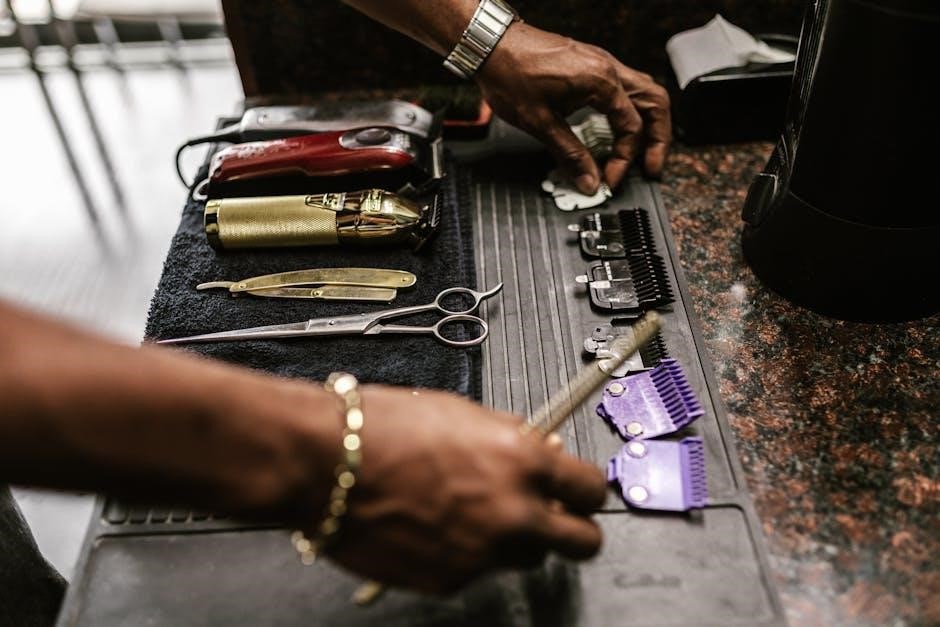A proper hair care routine is essential for maintaining healthy, vibrant hair. It involves understanding your hair type, using the right products, and following consistent practices to promote hair health and appearance. Regular cleansing, conditioning, and styling are fundamental steps, while protecting your hair from environmental factors and avoiding harmful habits ensures long-term benefits. By adopting a personalized approach, you can achieve the desired look and feel of your hair, enhancing both confidence and overall well-being.

Understanding Your Hair Type
Identifying your hair type is crucial for personalized care. Common types include straight, wavy, curly, and coily hair, each requiring tailored products and techniques for optimal health and manageability.
How to Determine Your Hair Type
To determine your hair type, avoid using styling products for a few days. Observe its natural texture and pattern. Straight hair lacks curls, while wavy hair has subtle bends. Curly hair forms defined spirals, and coily hair features tight, zig-zag patterns. Understanding your hair type helps you choose the right products and routines, ensuring your hair receives the care it needs for optimal health and appearance.
Common Hair Types: Straight, Wavy, Curly, and Coily
Hair is categorized into four main types: straight, wavy, curly, and coily. Straight hair falls flat without natural curls or waves. Wavy hair has soft, flowing bends; Curly hair forms defined spirals, while coily hair features tight, zig-zag patterns. Each type requires specific care to maintain its health and appearance, ensuring the right products and techniques are used to enhance its natural beauty and prevent damage.
Basic Hair Care Routine
A effective routine involves cleansing, conditioning, and styling while protecting hair from damage. Regular maintenance ensures healthy, strong hair that looks its best every day.
Step 1: Cleansing Your Hair
Cleansing is the foundation of any hair care routine. It removes dirt, oil, and product buildup, keeping your scalp and hair healthy. Use lukewarm water to open hair cuticles, and apply shampoo specifically formulated for your hair type. Gently massage the scalp to avoid irritation, then rinse thoroughly. Overwashing can strip natural oils, so frequency depends on hair type—curly hair may need less washing, while oily hair requires more frequent cleansing.
Step 2: Conditioning and Nourishing
Conditioning is crucial for moisturizing and protecting your hair after cleansing. Apply conditioner from mid-lengths to ends, avoiding the scalp, and leave it on for 1-2 minutes before rinsing with cool water. This step detangles hair, reduces frizz, and enhances shine. For deeper nourishment, consider a weekly deep conditioning treatment. Choose a conditioner suited to your hair type to address specific needs, such as dryness, damage, or color protection, ensuring optimal hydration and suppleness.
Step 3: Detangling and Protecting
Detangling is essential for preventing breakage and maintaining healthy hair. Use a wide-toothed comb or a detangling brush, starting from the ends and working upwards. Be gentle to avoid damaging your hair. After detangling, apply a leave-in conditioner or a protective serum to shield your hair from environmental damage and heat styling tools. Regularly trimming split ends also helps prevent further damage. Protecting your hair from excessive heat and harsh weather conditions ensures long-term health and vitality.

Product Selection for Your Hair
Selecting the right products for your hair type is crucial. Choose shampoos, conditioners, and treatments that cater to your hair’s specific needs, ensuring effective cleansing, nourishment, and protection.
Choosing the Right Shampoo
Selecting the right shampoo is essential for maintaining healthy hair. Shampoos are formulated for different hair types, such as dry, oily, curly, or color-treated hair. Look for ingredients that address your specific needs, like moisturizing agents for dry hair or clarifying properties for oily hair. Avoid harsh chemicals like sulfates if you have sensitive scalp or damaged hair. Always choose a shampoo that aligns with your hair type and concerns for optimal results and to prevent damage.
Selecting a Suitable Conditioner
Conditioner is crucial for moisturizing, detangling, and protecting hair after shampooing. Formulas vary, from deep conditioning treatments to leave-in products. Choose one with ingredients like argan oil for dry hair or protein for damaged hair. Ensure it complements your shampoo and suits your hair type. Avoiding sulfates and silicones may be beneficial for certain hair concerns.
Additional Products: Masks, Serums, and Styling Tools
Hair masks provide deep conditioning, repairing damage and enhancing moisture. Serums smooth frizz, add shine, and protect from heat. Styling tools like wide-tooth combs and heat protectants prevent breakage and damage. Choose products based on your hair type and needs, such as argan oil for dryness or keratin for strength. Regular use of these extras complements your routine, ensuring healthier and more manageable hair. Experiment to find what works best for your texture and style goals.

Maintaining Healthy Hair
Proper hair care involves regular cleansing, conditioning, and protection from damage. Using the right products and avoiding overstyling helps maintain strength and appearance, ensuring healthy, vibrant hair.
Daily Hair Care Tips
Start by washing your hair with lukewarm water to avoid stripping natural oils. Use conditioner after every wash to maintain moisture and softness. Detangle gently with a wide-tooth comb, starting from the ends. Avoid excessive heat styling and use a heat protectant when necessary. Minimize over-styling to prevent breakage. Trim your hair regularly to prevent split ends. Keep your scalp healthy by exfoliating occasionally. Stay hydrated to promote hair growth from within. These simple habits will keep your hair strong, shiny, and healthy every day.
Protecting Your Hair from Environmental Damage
Shield your hair from environmental stressors like UV rays, pollution, and humidity. Wear a hat or use a hair sunscreen with SPF to prevent color fade and dryness. Avoid hot water, which strips natural oils, and rinse with cold water to seal the cuticle. Use a hydrating mask weekly to replenish moisture lost due to environmental exposure. Apply a protective serum to shield against pollution and frizz. Regular trims can also help remove damaged ends caused by environmental factors, keeping your hair healthy and resilient.
Hair Styling and Protection
Hair styling and protection involve using gentle techniques and products to maintain health. Avoid excessive heat, use a wide-toothed comb, and embrace protective styles to minimize damage.
Styling Tips for Different Hair Types
Understanding your hair type is key to effective styling. For straight hair, use light products and avoid excessive heat. Wavy hair thrives with sea salt sprays and diffusers. Curly hair benefits from gentle scrunching and curl-defining creams. Coily hair requires moisturizing products and protective styles like braids or twists. Tailoring your technique to your hair’s texture ensures enhanced natural beauty and minimizes damage, promoting healthy and vibrant-looking hair for all types.
Using Protective Styles to Prevent Damage
Protective styles like braids, twists, and buns shield hair from environmental stress and mechanical damage. They reduce breakage, especially for curly and coily hair; Regularly moisturizing and avoiding tight styles are crucial. These styles also minimize manipulation, promoting hair growth. Opt for gentle products and maintain scalp health to enhance benefits. Protective styling is a practical way to preserve hair integrity while maintaining versatility and aesthetics.

Scalp Health and Hair Growth
A healthy scalp is crucial for hair growth. Maintaining proper hygiene, using gentle products, and managing conditions like dandruff can promote scalp health. Regular massages and a balanced diet rich in nutrients support hair growth. Avoid harsh chemicals and ensure proper hydration. Protecting the scalp from environmental stressors also contributes to a healthy hair growth environment.
The Importance of Scalp Care
A healthy scalp is the foundation of strong, vibrant hair. Proper scalp care prevents issues like dandruff, irritation, and flakiness, which can hinder hair growth. Regular cleansing with gentle products removes dirt and oil buildup, while scalp massages improve blood circulation, promoting hair health. A balanced diet rich in nutrients and hydration supports scalp well-being. Neglecting scalp care can lead to hair thinning and brittleness, making it essential to prioritize scalp health as part of your overall hair care routine.
Tips for Promoting Healthy Hair Growth
Promoting healthy hair growth starts with gentle care and avoiding damage. Use a wide-tooth comb to minimize breakage, and avoid harsh chemicals or excessive heat styling. Keep your scalp healthy through regular cleansing and massages to boost blood flow. Eat a balanced diet rich in vitamins, minerals, and proteins, and stay hydrated to nourish your hair from within. Regular trims and protective styles can also prevent split ends and encourage growth. Consistency and patience are key to achieving stronger, longer hair over time.
Seasonal Hair Care Tips
Adapt your hair care routine to seasonal changes. In summer, protect colored hair with color-protecting shampoos and wide-brimmed hats. In winter, minimize washing and use hydrating masks to combat dryness. Ensure your hair stays healthy and vibrant year-round by adjusting products and practices according to the season.
Hair Care in Summer
Summer hair care requires extra attention to protect your locks from heat and humidity. Use color-protecting shampoos for colored hair and wide-brimmed hats to shield from UV rays. Hydrating masks and deep conditioning treatments help combat dryness. Avoid frequent heat styling and opt for lightweight, water-based products to keep your hair moisturized. Regular trims can prevent split ends, and consider using UV protection sprays to safeguard your hair from sun damage. Keep your routine simple and nourishing to maintain healthy hair all season long.
Hair Care in Winter
Winter hair care focuses on combating dryness and damage from cold temperatures. Use hydrating shampoos and deep conditioning treatments to lock in moisture. Reduce heat styling and opt for nourishing masks to repair dry ends. Protect your hair from harsh winds with hats or scarves, and consider using leave-in conditioners for extra hydration. Trimming split ends regularly prevents breakage, while avoiding hot water helps maintain natural oils. Keep your hair healthy and vibrant throughout the colder months with consistent care.

Common Mistakes in Hair Care
Overwashing, using excessive heat styling, and improper conditioning are common mistakes. Using wrong products for your hair type and neglecting scalp health can cause damage and dryness.
Overwashing and Underconditioning
Overwashing strips natural oils, causing dryness and damage, while underconditioning leads to tangles and breakage. Using harsh products and hot water worsens these issues. It’s crucial to balance cleansing and nourishing. Limit washing frequency, use gentle shampoo, and deep condition regularly. This maintains moisture and prevents brittleness, ensuring healthy, manageable hair. Proper techniques help avoid these common mistakes, promoting long-term hair health and vitality.
Using the Wrong Products for Your Hair Type
Using products not suited for your hair type can lead to dryness, oiliness, or damage. For example, sulfates in shampoos can strip natural oils from dry or curly hair, while heavy conditioners may weigh down fine hair. Choosing products tailored to your hair’s specific needs ensures proper moisture balance and protection. Always select formulations designed for your hair type to avoid frizz, dullness, or breakage, and maintain healthy, vibrant hair. Proper product selection is key to optimal hair health.
A well-crafted hair care routine tailored to your hair type and needs is crucial for achieving healthy, vibrant hair. Consistency, the right products, and gentle care practices are key. By understanding your hair’s unique requirements and protecting it from damage, you can maintain its health and appearance. Embrace a personalized approach to hair care, and with time and effort, you’ll enjoy the rewards of strong, beautiful hair that enhances your confidence and overall well-being.
